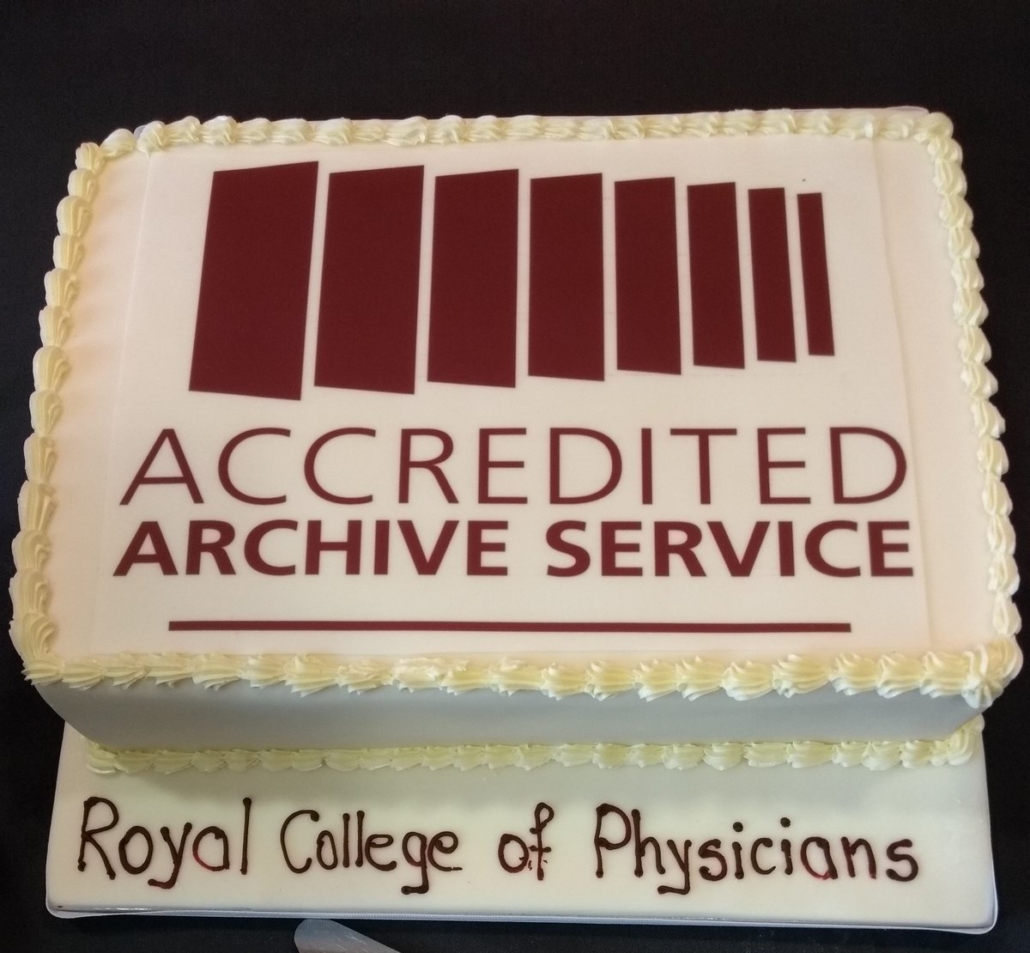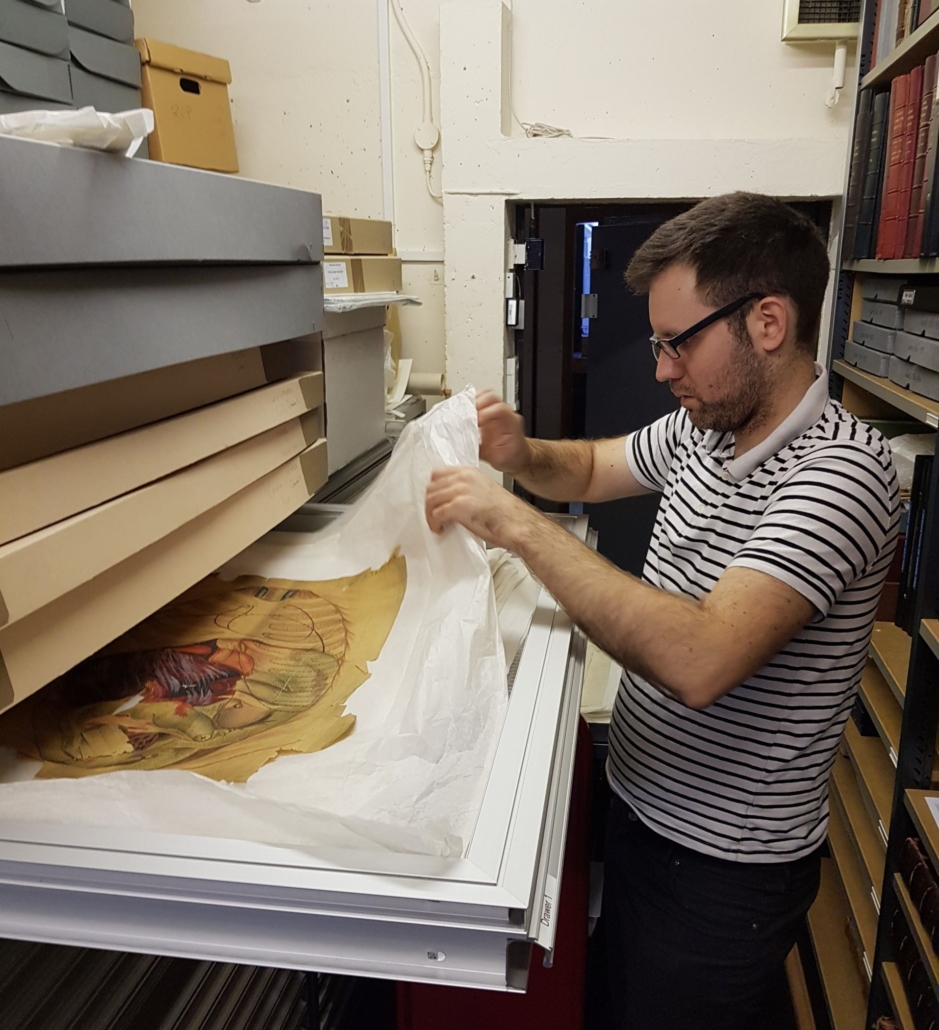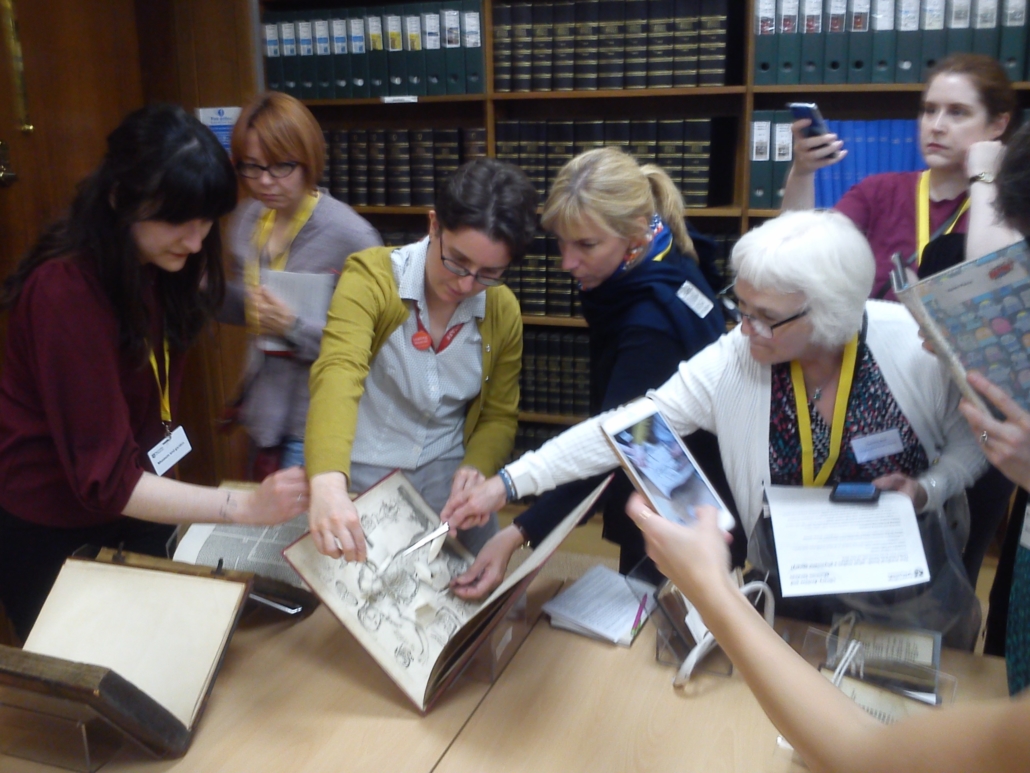Archive Accreditation: What it is. What it means. And how to get it.
In July 2019, the National Archives awarded Accredited Archive Service status to The Royal College of Physicians. Felix Lancashire describes the ups and downs of this journey to accreditation and what it means to the library.
Raising our profile: Personal reflections on Archive Accreditation
Felix Lancashire
Months of mulling over mission statements, staring at stats and perfecting policies have paid off for the Royal College of Physicians (RCP), as we’ve finally achieved Archive Service Accreditation. The accreditation scheme was launched in 2013 to recognise UK archives that meet national standards for collections development, care, and access provision. It is administered by a UK-wide committee, and for London and the rest of England, the assessor body is The National Archives (TNA). Accreditation can be used to celebrate great practice, advocate for the sector and drive improvement. For us, the process has helped raise the profile of the archives within the RCP and, more importantly, has helped us identify ways to make our service even better.
Some KQ partners have already achieved accreditation, and others may be part way through their application, or considering beginning the process. I would suggest that wherever you are in your accreditation journey, it is important to keep in mind what you want your service to get out of it. If it’s not something you’re considering, it could still be useful to check out the guidance documents, as these may provide ideas for future service planning and priorities.
Once my manager and I had decided to embark upon accreditation, way back in 2016, the first step was a trip to Durham for a workshop for prospective applicants. The event took place in the education room of Palace Green Library, and I admit that as I took my seat I felt I would much rather spend the day playing with the toys, arts supplies and dressing-up items that surrounded us, than wading through the enormous stack of guidelines, standards, and planning documents that I had, against all environmental sense, printed out and brought with me. Particularly daunting at that stage was the 4-part application form with its 131 questions, demanding information on everything from our building lease status and corporate governance structures, to our volunteer benefits and archive user feedback procedures. But the two representatives from TNA did their best to reassure everyone that the scheme recognises that every service is different, and that the application process is not about leaping arbitrary hurdles, but is a way for each service to demonstrate how its ways of doing things work for its collections, staff and users, in the context of its size, setting, budget and aims. Our TNA colleagues encouraged us to keep in touch, to let them know how we were getting on, when we planned to submit our applications, and bombard them with as many questions as we could think of. Over the ensuing months (and years!), I certainly took advantage of this last offer, and throughout the process everyone at TNA was extremely helpful, generous and friendly, in answering questions, giving advice and providing support.
Back in London, my manager and I divvied up the application form sections and necessary tasks. She would do all the really boring bits, relating to governance, finance, and organisational planning procedures, and I would do much of the rest. I wrote a new collections information & access policy and tightened up our volunteer policy and acquisition & disposal policy, while my manager beefed up our collections care & conservation policy. We both took the opportunity to refine our cataloguing manual and other procedural documents. Working out the timing of these tasks was important, as the new and updated policies would have to be approved by the Library, Archive and Museum Services (LAMS) Management Committee, whose biannual meeting dates were set in stone.
The most enjoyable parts of the process for me were surveying our collections and storage areas to get up-to-date figures (for example, for volume of catalogued vs uncatalogued material and volume of free space); and the creation of an archival handling guide to improve the induction process for new volunteers and staff. When frustrations arose, it was often due to forgetting the cardinal rule: just explain how what you do works for you. For example, as many elements of our services are highly integrated with the LAMS team’s library and museum services (particularly in terms of reading room use, engagement activities, and exhibitions), I would often get bogged down trying to disentangle the archive-specific data. However, once I embraced the fact that the application form could be used as flexibly as need be, it became much simpler to just provide the data we had and explain whether it applied only to the archives or to LAMS as a whole. Similarly, as we were (and are) developing our digital preservation procedures at the same time we were completing the accreditation documentation, I would often agonise over how to answer questions relating to digital preservation. It sounds obvious now, but it took me a while to accept that I should stop worrying about what I thought the assessors wanted to hear, and simply describe where we were, at time of writing, in relation to digital preservation. It helped a lot that we do have an excellent and well-managed collection of oral history recordings, which I was able to focus on when answering questions about digital material.
It was incredibly helpful to be able to draw on the support of friends at institutions who had already been through the accreditation process, particularly Kingston History Centre and the Royal College of Obstetricians and Gynaecologists. Our wonderful colleagues in the LAMS team were extremely supportive and helpful, as well as patient in the face of badgering on subjects such as risk assessment, pest monitoring and social media analytics.
After submitting the application and supporting documentation (policies etc), the next step was to arrange for an assessment visit. The assessment team consisted of one colleague from TNA and one from a peer archive service. They sent over in advance a list of the topics they particularly wanted to discuss based on the application, so there were no nasty surprises on the day! A big part of accreditation is demonstrating the position of the archives within its parent organisation, so we were pleased that the head of LAMS and the CEO of the RCP were able to join us for the conversation with the assessors during the visit. The conversation was very relaxed, and mostly involved explaining certain aspects of the service in more detail, as well as specific projects we had mentioned in the application. We also took the assessors on a tour of the archive stores, reading room and exhibition space.
Following the visit, we had to wait a month before the panel met that would decide whether we were awarded accreditation or not. (These panels are held on set dates throughout the year, so if you are considering applying it is a good idea to know which panel you’re aiming for; applicants aren’t involved in the panels, but the decision is made based on the application form and the assessors’ report.)
Happily, the news from the panel was good, but our successful application result is far from the end of the road. We will be reassessed in 5 or so years’ time, and, more importantly, thanks in part to the accreditation process we now have a clearer plan for developing the service over the coming years. Among the improvements we plan to make will be:
- A more active collections development approach focussed on identifying and filling gaps in the collection (for example, we have thousands of records created by doctors, but we’d like more that demonstrate the experiences of patients)
- Implementing more reliable and effective environmental control procedures for our storage areas
- More sophisticated use of analytics to improve the effectiveness of our catalogue and other online resources
If any KQ partners are currently in the process of applying for accreditation, we’d like to wish them the best of luck and invite them to get in touch if they think we could be of any help whatsoever. You can find out a bit more about the RCP’s collections, as well as links to our catalogues, by visiting our web pages.




